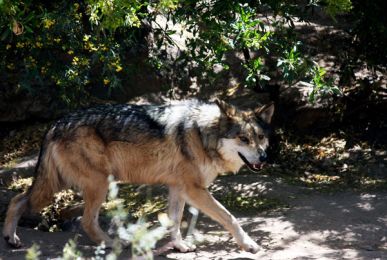In the News: Group will sue feds over wolf trapping
By Brandon Loomis
 An environmental group has notified federal authorities that it will sue to block them from trapping wolves that wander into Arizona and New Mexico from Mexico or the northern Rocky Mountains.
An environmental group has notified federal authorities that it will sue to block them from trapping wolves that wander into Arizona and New Mexico from Mexico or the northern Rocky Mountains.
On Wednesday, the Center for Biological Diversity announced its intent to sue the U.S. Fish and Wildlife Service over a 2011 rule it adopted allowing agents to trap and relocate wolves wandering north of Interstate 40 or south of Interstate 10. Those areas are outside the agency’s Mexican gray wolf recovery zone — a 4.4 million-acre swath centered in Arizona’s Apache National Forest and New Mexico’s Gila National Forest, where reintroduced wolves are considered experimental under the Endangered Species Act.
Outside the recovery zone, wolves enjoy fuller protection as an endangered species. The group asserts that this means they should be allowed to roam “perfectly good wolf habitat” regardless of where they originated.
“Despite that full protection, the Fish and Wildlife Service surreptitiously granted itself a permit to remove wolves from those areas,” said Michael Robinson, conservation advocate for the Center for Biological Diversity. The group is challenging the rule in part because it was made without public involvement.
Fish and Wildlife officials declined to comment because the matter will be in court. The group has 60 days to file its lawsuit in federal court and has not decided whether to do so in Arizona, New Mexico or Washington, D.C.
Unlike the program to introduce gray wolves into Yellowstone National Park and the northern Rockies, the Southwest’s reintroduction program has not lived up to projections. Federal biologists in the late 1990s had predicted more than 100 wolves would roam the two states by now, but last year, they counted only 58.
In recent years, it has grown more likely that wolves could come into the states from the booming population in Wyoming or from Mexico’s reintroduction efforts near the border.
Wolf advocates believe that the rules Fish and Wildlife established before reintroducing wolves into the Blue Range that straddles the Arizona/New Mexico line impeded recovery, compared with the similar effort in the northern Rockies.
For one thing, wolves that leave the national forests that constitute the recovery zone are captured and returned. They are not allowed to broaden their range.
Besides authorizing 12 wolf kills — permitted when the animals prey on livestock — the agency has captured dozens more and accidentally killed 18, Robinson said. An additional 35 were caught and never released, which Robinson’s organization fears will happen to stragglers entering from outside the Southwestern states.
“It’s very likely that any wolves captured under the authority we’re challenging “¦ would simply stay behind wire,” he said.
Arizona Game and Fish officials also play a role in managing wolves. Efforts to reach an agency representative on Wednesday were unsuccessful.
A count of the region’s wolf population is due from Fish and Wildlife next month.
****************************************************************************************************************************************
This article was published in the AZ Republic.
Similar articles also appeared in several other papers:
Las Cruces Sun-News
Albuquerque Journal
Alamogordo News
San Francisco Chronicle
The Tucson Weekly
The Summit County Voice
Please submit a letter to the editor of these papers supporting the Center’s efforts to secure protections for Mexican gray wolves, who are native to both Mexico and the United States.
You can join our email list and receive Mexican wolf news and actions alerts here.
Visit us on Facebook here.
Photo by Kaite Flynn



